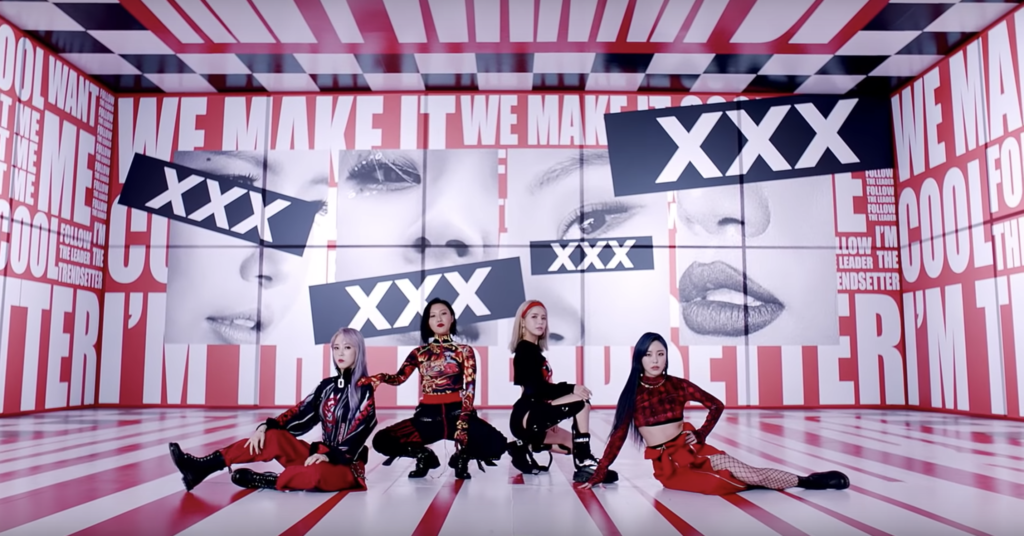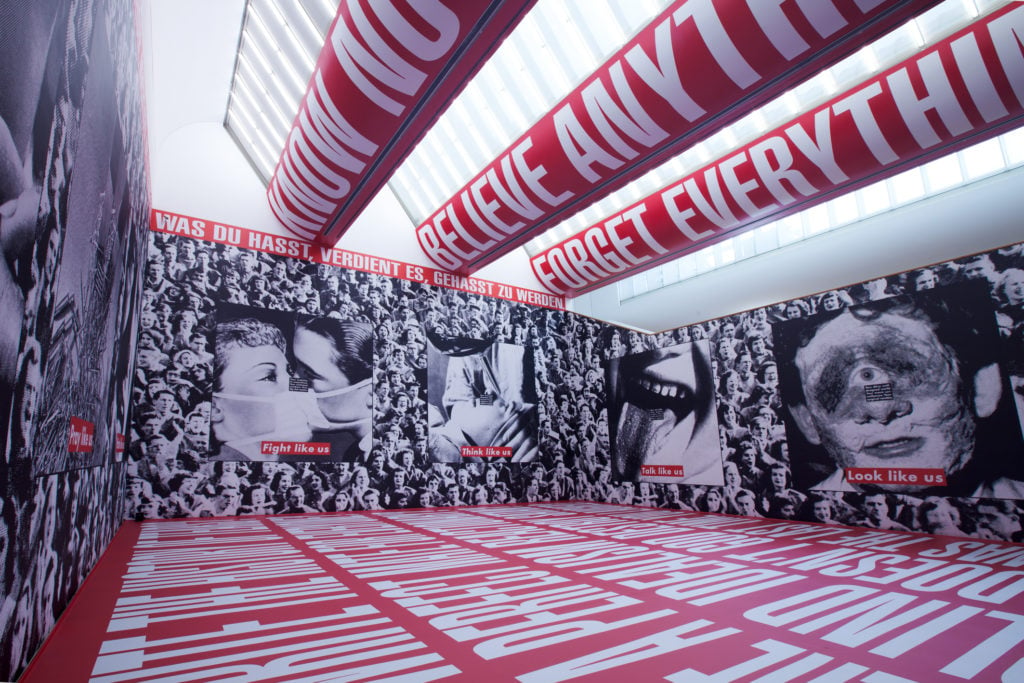Art World
Did This K-Pop Girl Group Rip Off a Classic Barbara Kruger Installation for Its New Video? It Certainly Looks Like It
The new video from Mamamoo has quickly gone viral.

The new video from Mamamoo has quickly gone viral.

Kate Brown

The video for the chart-topping K-Pop band Mamamoo’s fiery new single “HIP” may look familiar to some audiences. It appears to have borrowed heavily from artist Barbara Kruger’s 1994/1995 installation Untitled, a controlled mess of ad imagery and slogans in white font on a red background that climb the walls, floors, and ceiling. In Mamamoo’s video, Kruger’s black-and-white ad photos appear to have been swapped for images of the four female performers, Hwasa, Wheein, Solar, and Moonbyul, with “XXX” pasted over their mouths and eyes. On the wall are texts, which appear in Kruger’s signature white, red, and black Futura Bold font, that spell out phrases like “Follow the Leader” and “Trendsetter.”
“HIP,” which came out in mid-November, has 29 million views on YouTube so far, making its use of Kruger’s art—which has long criticized the use of women’s bodies in consumerism—particularly rich. In “HIP,” we watch a group of 20-somethings gyrating while whisper-singing lyrics like “all I wanna be is cool”—a phrase that one could easily imagine in a work by Kruger.
“This is another illustration of the power and influence of Barbara Kruger’s work, which transcends the boundaries of visual art,” Monika Sprüth and Philomene Magers, Kruger’s longtime art dealers, told Artnet News. “Now, some 35 years after we first started working with her, we see Kruger’s visual language replicated on a multi-generational and global scale,” the dealers add. Kruger did not respond to a request for comment, nor did representatives for Mamamoo.
This isn’t the first time Kruger’s work appears to have inspired zeitgeisty branding. The streetwear label Supreme has notoriously made use of her white-on-red text for much of its ads and clothing labels. In a very apparent jab at Supreme in 2017, Kruger launched a pop-up store for Performa that sold skate decks and shirts.
By that point she’d already publicly called out Supreme for using her insignia when the label tried to take someone else to court for copyright in 2013. “What a ridiculous clusterfuck of totally uncool jokers. I make my work about this kind of sadly foolish farce. I’m waiting for all of them to sue me for copyright infringement,” she told Complex during the controversy.

Installation View of Barbara Kruger’s Untitled (1994/1995) in the show “Not Yet Titled Museum” at Museum Ludwig, Cologne © Barbara Kruger, New York. Photo: Rheinisches Bildarchiv Cologne/Sabrina Walz.
Given the tragic drama engulfing the K-Pop world at the moment, the use of Kruger’s imagery also strikes a particularly ominous note in this context. This fall, singers Sulli, 25, and Goo Hara, 28, were found dead in separate incidences, both suspected to have committed suicide following cyberbullying from fans, according to New York Times. The members of Mamamoo have said “HIP” is about ignoring the criticism of others. The group has, along with a few other K-Pop, canceled recent performances out of respect for the deaths of their fellow artists.
Some have been critical of the genre. Yonden Lhatoo, chief news editor of South China Morning Post, called the proliferation of K-Pop an “infectious disease” after another singer died in 2017. “Would-be K-pop stars, while still underage, are regularly locked into unbelievably unfair contracts and incarcerated in grueling boot camps for training, a good decade before they get to even record a song, let alone become famous,” wrote Yonden in an opinion column. “The ones who are lucky enough to make it end up paying off debts and earning a pittance for years.”